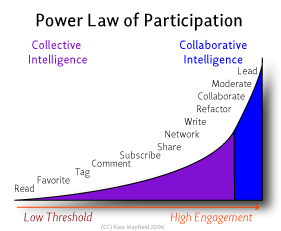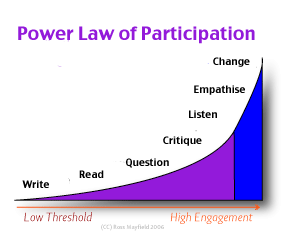Ross Mayfield has made a nice graph of a continuum of participation in social software and online communities:
I use something similar in my PhD, talking more specifically about ‘creative’ and ‘network’ literacies. But I was struck by the way that the continuum moves from ‘passive’ consumption through to mastery and control. Something that I’ve struggled with all along in my research is theorising the pay-off of increased literacy and cultural participation – that is, participation in what? and what for?
So, I was thinking, what if the pay-off was something other than (or in addition to) the growth of profit for social software developers, or even ‘innovation’ and ‘knowledge creation’? What if I started again and thought about how cultural participation through consumer-created media might actually have positive implications for cultural citizenship? Would the graph look different? So I made this to try and think it through:
Current thesis word count: 25,355


3 responses to “the uses of participation”
I talk about participation and different populations of, in my research, enthusiasts. Have you seen the diagram made of Bert Moorhouse’s conception of an ‘enthusiasm’ in Abercrombie and Longhurst’s _Audiences: A Sociological Theory of Performance and Imagination_? It would map onto the ross mayfield graph but with a distinction made between professionals and amateurs, thus introducing some element of political economy (which was also missing from Levy’s _Collective Intelligence_). Maybe Mayfield does address this, dunno. What is problematic about a continuum of “‘passive’ consumption through to mastery and control” is that consumers or whatever on the ‘passive’ already have a set of skills and relationships to technology that demand a level of ‘mastery and control’!! I am thinking of Mackenzie’s argument in _Transductions_ here. What is being assumed is a set of certain skills or a threshold of proficiency (perhaps that enable certain outcomes) that bumps someone up on a cultural scale termed ‘skill and mastery’, ie one moves from a category of ‘stave’ to the category of ‘grand wizzard’. It is a threshold effect, because once you cross the threshold (or recognised as such) you enter into new relations with other participants and the socio-technical mechanisms that mediate between them.
I have thought a lot about the mechanisms by which the cultural industry reproduces and mediates between ‘amateur’ and ‘profesional’ (and ‘interested public’ and ‘mass public’) populations, through such things as magazines, events (car shows, motorsport, etc), websites, etc. Maybe some of that sort of thinking could help with the ‘participation in what’ question?
I like your graph for one main reason: ‘Empathise’ clearly is an affective mode of engagement. It is interesting that you use the term ‘cultural citizenship’ because in Toby Miller’s recent talks on the subject he didn’t mention the affective domain at all (except in passing to talk about the difference between passionate for archaic cultural forms and the rationality of governance).
There would need to be a feedback loop between ‘Critique’ and ‘Listen’ (just as there would need to be a feed back mechanism in mayfield’s ‘collaborative’ zone), and a much bigger feedback loop to get to ‘Change’, I was wondering what the nature of this feedback is or would be? The feedback would be between a participant and whatever they are participating in/with: What socio-technical mechanisms enable mediation between the groups of user/participant/producer/somethings? One type I am thinking of are the various niche media, or large websites/blogs that feed news, information, events between different levels of the participation political economy.
Beautiful Jean.
I wonder if there could ever be a graph to represent ‘listen’ as an intrinsic or default mode throughout the process rather than only one stage.
I’m reminded of your anti-blogging t-shirt phase!
Notes on Designing for Participation…
I participated on a panel at Webvisions about encouraging companies to engage customers online. I wanted to put down what I said in a coherent manner for those who weren’t there….